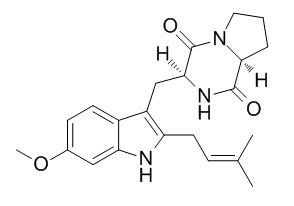Tryprostatin A
Tryprostatin A is an inhibitor of breast cancer resistance protein. Tryprostatin A and tryprostatin B are indole alkaloid-based fungal products that inhibit mammalian cell cycle at the G2/M phase.
Inquire / Order:
manager@chemfaces.com
Technical Inquiries:
service@chemfaces.com
Tel:
+86-27-84237783
Fax:
+86-27-84254680
Address:
1 Building, No. 83, CheCheng Rd., Wuhan Economic and Technological Development Zone, Wuhan, Hubei 430056, PRC
Providing storage is as stated on the product vial and the vial is kept tightly sealed, the product can be stored for up to
24 months(2-8C).
Wherever possible, you should prepare and use solutions on the same day. However, if you need to make up stock solutions in advance, we recommend that you store the solution as aliquots in tightly sealed vials at -20C. Generally, these will be useable for up to two weeks. Before use, and prior to opening the vial we recommend that you allow your product to equilibrate to room temperature for at least 1 hour.
Need more advice on solubility, usage and handling? Please email to: service@chemfaces.com
The packaging of the product may have turned upside down during transportation, resulting in the natural compounds adhering to the neck or cap of the vial. take the vial out of its packaging and gently shake to let the compounds fall to the bottom of the vial. for liquid products, centrifuge at 200-500 RPM to gather the liquid at the bottom of the vial. try to avoid loss or contamination during handling.
Asian Journal of Chemistry2014, 26(8):2425
J Ethnopharmacol.2017, 206:73-77
Int Immunopharmacol.2023, 125:111175.
HortTechnology2016, 26(6):816-819
Trop J Nat Prod Res2023, 7(12):5611-5615.
J Pharmacopuncture.2023, 26(4):357-365.
Curr Pharm Des.2024, 30(1):71-80.
J Food Biochem.2021, 45(7):e13774.
Current Pharmaceutical Analysis2017, 13(5)
Applied Biological Chemistry 2021, 64(75)
Related and Featured Products
Jacobs J Biotechnol Bioeng. 2015 Apr;2(1).
Engineered Production of Tryprostatins in E. coli through Reconstitution of a Partial ftm Biosynthetic Gene Cluster from Aspergillus sp.[Pubmed:
26640821 ]
METHODS AND RESULTS:
Tryprostatin A and B are indole alkaloid-based fungal products that inhibit mammalian cell cycle at the G2/M phase.
They are biosynthetic intermediates of fumitremorgins produced by a complex pathway involving a nonribosomal peptide synthetase (FtmA), a prenyltransferase (FtmB), a cytochrome P450 hydroxylase (FtmC), an O-methyltransferase (FtmD), and several additional enzymes. A partial fumitremorgin biosynthetic gene cluster (ftmABCD) from Aspergillus sp. was reconstituted in Escherichia coli BL21(DE3) cells, with or without the co-expression of an Sfp-type phosphopantetheinyltransferase gene (Cv_sfp) from Chromobacterium violaceum No. 968.
CONCLUSIONS:
Several recombinant E. coli strains produced tryprostatin B up to 106 mg/l or Tryprostatin A up to 76 mg/l in the fermentation broth under aerobic condition, providing an effective way to prepare those pharmaceutically important natural products biologically.
Bioorg Med Chem. 2008 Apr 15;16(8):4626-51.
Synthesis and structure-activity relationship studies on tryprostatin A, an inhibitor of breast cancer resistance protein.[Pubmed:
18321710 ]
Tryprostatin A is an inhibitor of breast cancer resistance protein, consequently a series of structure-activity studies on the cell cycle inhibitory effects of Tryprostatin A analogues as potential antitumor antimitotic agents have been carried out.
METHODS AND RESULTS:
These analogues were assayed for their growth inhibition properties and their ability to perturb the cell cycle in tsFT210 cells. SAR studies resulted in the identification of the essential structural features required for cytotoxic activity. The absolute configuration L-Tyr-L-pro in the diketopiperazine ring along with the presence of the 6-methoxy substituent on the indole moiety of 1 was shown to be essential for dual inhibition of topoisomerase II and tubulin polymerization. Biological evaluation also indicated the presence of the 2-isoprenyl moiety on the indole scaffold of 1 was essential for potent inhibition of cell proliferation. Substitution of the indole N(a)-H in 1 with various alkyl or aryl groups, incorporation of various L-amino acids into the diketopiperazine ring in place of L-proline, and substitution of the 6-methoxy group in 1 with other functionality provided active analogues. The nature of the substituents present on the indole N(a)-H or the indole C-2 position influenced the mechanism of action of these analogues. Analogues 68 (IC(50)=10 microM) and 67 (IC(50)=19 microM) were 7-fold and 3.5-fold more potent, respectively, than 1 (IC(50)=68 microM) in the inhibition of the growth of tsFT210 cells.
CONCLUSIONS:
Diastereomer-2 of tryprostatin B 8 was a potent inhibitor of the growth of three human carcinoma cell lines: H520 (IC(50)=11.9 microM), MCF-7 (IC(50)=17.0 microM) and PC-3 (IC(50)=11.1 microM) and was equipotent with etoposide, a clinically used anticancer agent. Isothiocyanate analogue 71 and 6-azido analogue 72 were as potent as 1 in the tsFT210 cell proliferation and may be useful tools in labeling BCRP.
Int J Cancer. 2003 Dec 10;107(5):721-8.
Reversal of breast cancer resistance protein-mediated drug resistance by tryprostatin A.[Pubmed:
14566821]
MDR in human cancers is one of the major causes of failure of chemotherapy. A member of the superfamily of ABC transporters, BCRP, was demonstrated to confer an atypical MDR phenotype to tumor cells.
METHODS AND RESULTS:
To overcome the BCRP-mediated drug resistance, the fungal secondary metabolite TPS-A, a diketopiperazine, was analyzed with regard to its potency to reverse the BCRP-mediated drug-resistant phenotype. At concentrations of 10-50 microM, TPS-A reversed a mitoxantrone-resistant phenotype and inhibited the cellular BCRP-dependent mitoxantrone accumulation in the human gastric carcinoma cell line EPG85-257RNOV, the human breast cancer cell line MCF7/AdrVp (both exhibiting acquired BCRP-mediated MDR) and the BCRP cDNA-transfected breast cancer cell line MCF-7/BCRP clone 8. No cytotoxicity was seen at effective concentrations.
CONCLUSIONS:
These data indicate that TPS-A is a novel BCRP inhibitor.



